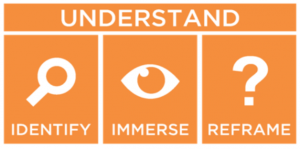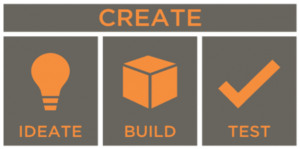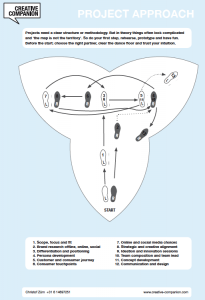What happened this week?
This week, we learned about design thinking. Design For America presented and led a small workshop during the class period. Taken from the group’s website, “Design for America is an idea incubator, a motivated community, and a way of approaching complicated challenges. DFA shapes the next generation of social innovators.” I am in a social entrepreneurial group on campus called Enactus – previously, I thought we were the only organization devoted to social good not through volunteerism, but through sustainable solutions. I was pleasantly surprised to learn more about Design For America and how the group creates designs (of both products and processes) to help others help themselves. I’m sad I’m a senior now and do not have the time to join the organization!
So what?
Design thinking is a strategy designers use to create new solutions. The process is first to understand then to create. Under the pillar of “understand” comes identifying, immersing, and reframing. One of the most important parts of the design process is to correctly identify the need. Something the DFA team said that really stood out to me was that a designer should look at the need first then make several different, creative solutions. It seems like common sense, but more often than not, I am thinking more of the product in the beginning of my design thinking process than the need group. I will try to thoroughly assess the need first in the future.

Under the pillar of “create” comes the last three steps of the design thinking process. Ideation, building, and testing are the more tangible parts of the process. At any time, a designer can go back to any point in the process – it’s not supposed to be static.

I’ve found an interesting article on “music thinking” and how it’s connected to design thinking. When musicians create a piece of music, they also go through the design thinking process. The only difference is that their product isn’t tangible. And steps like collecting user stories are accomplished through showing compositions to friends, fellow musicians, and professionals in the industry. According to the article, music thinking “reflects the dynamics of daily business, working together with different experts, have to perform everyday on an high expectation level in different performance venues for an changing audience. Music thinking also knows ‘radical change’ in style, technical innovation and behavior of the crowd, customer, consumer, user, downloader. Music thinking is the behavioral side of design thinking.”
The article goes on to apply this thinking to a dancer’s routine creation. Find the article here. We learn a lot about things like design or music thinking in classes that might seem like common sense – but I believe we can’t fully grasp the concepts of these things unless we acknowledge them and apply a name to them. So, while it might be true that starting with a lot of ideas, narrowing them down, and making a few iterations of a final product can be done by someone who does not know what design thinking is, there is power in acknowledging the concept and being able to check each step off the list as you design.

Now What?
I have also found this TedTalk on design thinking. The speaker talks about how sometimes, designers have to be taught to relive their childhoods in order to effectively create innovative designs. The talk is very interesting and goes into a lot more than I mention – it can be found here. I previously mentioned that I have been thinking too much about the product before I correctly identify the need group. Going forward with the group project and my own designs, I am going to spend longer on the identifying and reframing aspects of design thinking. I will also try to maintain that “child-like” creativity by not limiting my ideas before I put them on paper.

Hi Aubrey,
I thought you did a great job of breaking down what the various pillars of design thinking are, and I really resonated with the point you made about how quite often, we are guilty of coming up with the product design in our minds before truly assessing the need/user requirements. I also enjoyed the article you shared about music thinking–I suppose any form of artistic expression is a highly iterative process that requires creativity as well as empathy, so it lends itself to the design process quite well.
Hi Aubrey,
I enjoyed working with you and Shayna this past week while going through the Design Process. I also found your comment about “music thinking” to be very interesting. I have never been exposed to the creation of an artist’s music, but it makes sense that their process would be similar to the Design Process. It is very easy for consumers, like myself, to think that a song simply comes together once the lyrics and written, but I am now much more aware that artists have plenty of opportunities to apply different beats/tones/styles to their lyrics. Just like the Design Process, the artists that we know and love release their creation to the public after iterating through many different “song prototypes.”
-Scott Provenzano